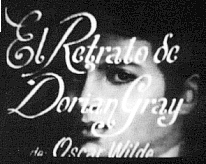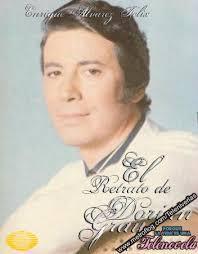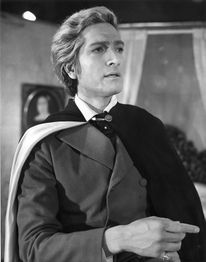El Retrato de Dorian Gray (lost Mexican TV drama based on Oscar Wilde novel; 1969): Difference between revisions
(Created page with "{{InfoboxLost |title=<center>El retrato de Dorian Gray (The Picture of Dorian Gray)</center> |image=El_retrato_de_Dorian.jpg |imagecaption=Possibly the title card of the TV Dr...") |
No edit summary |
||
| Line 5: | Line 5: | ||
|status=<span style="color:red;">'''Lost'''</span> | |status=<span style="color:red;">'''Lost'''</span> | ||
}} | }} | ||
In 1890, Irish author Oscar Wilde published an early version of his novel "The Picture of Dorian Gray" for the first time on the ''Lippincott's Monthly Magazine''. Later on 1891, the final revised version was published by Ward Lock & Co. The novel itself was an object of controversy because it was " 'mawkish and nauseous, unclean, effeminate and contaminating". Since the novel showed a homoerotic nature and a strong criticism to the society of that time, the controversy around it leaded to a series of trials against Oscar Wilde, that led to the arrest of Wilde, passing two years of forced labor in Newgate Prison, later moved to Pentonville Prison, later to Wandsworth Prison, and finally to Reading Gaol (where Wilde wrote ''The Ballad of Reading Gaol''). | |||
The Picture of Dorian Gray, even with all the controversy and the censorship, became a universal classic of literature. This because of the topics that were treated and criticized, like the | "The Picture of Dorian Gray," even with all the controversy and the censorship, became a universal classic of literature. This because of the topics that were treated and criticized, like the burgess society and the immorality around it. | ||
The first adaptation of the novel to cinema was | The first adaptation of the novel to the cinema was in 1945, with the homonym movie "The Picture of Dorian Gray", starring Hurd Hatfield, George Sanders, and Angela Lansbury. | ||
A long line of adaptations and based-of works came along the time | A long line of adaptations and based-of works came along the time, including the 1969 Mexican TV drama '''''El Retrato de Dorian Gray''''', produced by Enrique Alonso and broadcasted on channel 4 (now channel 2, "Las Estrellas"), by Telesistema Mexicano (known today as Televisa Mexico). | ||
== Plot == | ==Plot== | ||
The plot is presumably the same as the original novel, | The plot is presumably the same as the original novel, as it centers around Dorian Gray, a naive and young gentleman that becomes the favorite model of Basile Hallward, a painter who is fascinated with the youth and beauty of Gray. They soon meet Lord Henry Wooton, a close friend of Basile, who gives some sort of advice to Dorian, about seizing his youth and beauty and to live his life as he wants. Unfortunately, this advice makes Dorian wish to never grow old and to not lose his beauty, making an unconscious pact with the devil to make this come true. | ||
== Cast == | ==Cast/Development== | ||
The cast of the drama was composed of actors of the time, featuring Enrique Alvarez Felix, son of the actress Maria Felix, as Dorian Gray<ref>[https://web.archive.org/web/20140109210135/http://www.seriesnow.com/latinamerican-actors/enrique-alvarez-felix.html WebArchive page | The cast of the drama was composed of actors of the time, featuring Enrique Alvarez Felix, son of the actress Maria Felix, as Dorian Gray.<ref>[https://web.archive.org/web/20140109210135/http://www.seriesnow.com/latinamerican-actors/enrique-alvarez-felix.html A WebArchive page that listed all the protagonist roles of Alvarez Felix.] Retrieved 23 Nov '18</ref> The role of Lord Henry Wooton was performed by Carlos Bracho, Lady Wooton performed by Carmen Montejo, and Silvia Pasquel as Sybil Vane. | ||
Although this work is referenced on the | Although this work is referenced on the biographic articles on Enrique Alvarez Felix, there is no register of the drama on the official Televisa website, along with the show not mentioned on other official media. However, some fansites have collected information about this show. Unfortunately, there is very little information on the casting of the show. Only an IMDB page has some information on the casting, and only one still of Carlos Bracho on his role of Lord Henry has been found. | ||
On the IMDB website, it | On the IMDB website, it's been said that the show was recorded on B/W format, although on the Spanish Wikipedia page for the show, it is said that this was the first TV drama to be broadcasted on color for Televisa, but also mentions that the recordings were in B/W. It is possible that it was recolored in the official broadcast, but this information remains unconfirmed. Only three chapters were produced or recorded, but the plot of each one is unknown. | ||
== | ==Availability== | ||
There has not been any retransmission of the drama, neither on any streaming pirate site, video sites as YouTube or Dailymotion, | There has not been any retransmission of the drama, neither on any streaming pirate site, video sites as YouTube or Dailymotion, or on the Televisa official streaming network Blim. There is neither any DVD or BluRay edition of this classic, and for the silence that Televisa and crew have remained about the TV show, is probably that the show would never see the light again. | ||
It is believed that this | It is believed that this happened because in the 1980s, Televisa announced that they would ban all homosexual actors and actresses. An ironic decision on Televisa's part, as they made a drama based on a novel fuelled with homoerotic tendencies. Even after some protests around the topic of removal, the actors/actresses were not removed from their jobs, but apparently, some works could give hints about homosexuality. | ||
== Gallery == | ==Gallery== | ||
<gallery> | <gallery mode=packed heights=175px> | ||
El_retrato_de_dorian_gray_tv_series-403524138-mmed.jpg|Promotional still, featuring Enrique Alvarez Felix. | El_retrato_de_dorian_gray_tv_series-403524138-mmed.jpg|Promotional still, featuring Enrique Alvarez Felix. | ||
Lord Henry Carlos Bracho.jpeg|Carlos Bracho, performing Lord Henry Wooton. | Lord Henry Carlos Bracho.jpeg|Carlos Bracho, performing Lord Henry Wooton. | ||
</gallery> | </gallery> | ||
==External Links== | |||
*[https://www.imdb.com/title/tt0373599/ IMDb page about the show.] Retrieved 23 Nov '18 | |||
*[https://es.wikipedia.org/wiki/El_retrato_de_Dorian_Gray_(telenovela) A Spanish Wikipedia article about the show.] Retrieved 23 Nov '18 | |||
== | ==Reference== | ||
{{reflist}} | |||
[[Category:Lost TV]] | |||
Revision as of 01:17, 24 November 2018
In 1890, Irish author Oscar Wilde published an early version of his novel "The Picture of Dorian Gray" for the first time on the Lippincott's Monthly Magazine. Later on 1891, the final revised version was published by Ward Lock & Co. The novel itself was an object of controversy because it was " 'mawkish and nauseous, unclean, effeminate and contaminating". Since the novel showed a homoerotic nature and a strong criticism to the society of that time, the controversy around it leaded to a series of trials against Oscar Wilde, that led to the arrest of Wilde, passing two years of forced labor in Newgate Prison, later moved to Pentonville Prison, later to Wandsworth Prison, and finally to Reading Gaol (where Wilde wrote The Ballad of Reading Gaol).
"The Picture of Dorian Gray," even with all the controversy and the censorship, became a universal classic of literature. This because of the topics that were treated and criticized, like the burgess society and the immorality around it.
The first adaptation of the novel to the cinema was in 1945, with the homonym movie "The Picture of Dorian Gray", starring Hurd Hatfield, George Sanders, and Angela Lansbury.
A long line of adaptations and based-of works came along the time, including the 1969 Mexican TV drama El Retrato de Dorian Gray, produced by Enrique Alonso and broadcasted on channel 4 (now channel 2, "Las Estrellas"), by Telesistema Mexicano (known today as Televisa Mexico).
Plot
The plot is presumably the same as the original novel, as it centers around Dorian Gray, a naive and young gentleman that becomes the favorite model of Basile Hallward, a painter who is fascinated with the youth and beauty of Gray. They soon meet Lord Henry Wooton, a close friend of Basile, who gives some sort of advice to Dorian, about seizing his youth and beauty and to live his life as he wants. Unfortunately, this advice makes Dorian wish to never grow old and to not lose his beauty, making an unconscious pact with the devil to make this come true.
Cast/Development
The cast of the drama was composed of actors of the time, featuring Enrique Alvarez Felix, son of the actress Maria Felix, as Dorian Gray.[1] The role of Lord Henry Wooton was performed by Carlos Bracho, Lady Wooton performed by Carmen Montejo, and Silvia Pasquel as Sybil Vane.
Although this work is referenced on the biographic articles on Enrique Alvarez Felix, there is no register of the drama on the official Televisa website, along with the show not mentioned on other official media. However, some fansites have collected information about this show. Unfortunately, there is very little information on the casting of the show. Only an IMDB page has some information on the casting, and only one still of Carlos Bracho on his role of Lord Henry has been found.
On the IMDB website, it's been said that the show was recorded on B/W format, although on the Spanish Wikipedia page for the show, it is said that this was the first TV drama to be broadcasted on color for Televisa, but also mentions that the recordings were in B/W. It is possible that it was recolored in the official broadcast, but this information remains unconfirmed. Only three chapters were produced or recorded, but the plot of each one is unknown.
Availability
There has not been any retransmission of the drama, neither on any streaming pirate site, video sites as YouTube or Dailymotion, or on the Televisa official streaming network Blim. There is neither any DVD or BluRay edition of this classic, and for the silence that Televisa and crew have remained about the TV show, is probably that the show would never see the light again.
It is believed that this happened because in the 1980s, Televisa announced that they would ban all homosexual actors and actresses. An ironic decision on Televisa's part, as they made a drama based on a novel fuelled with homoerotic tendencies. Even after some protests around the topic of removal, the actors/actresses were not removed from their jobs, but apparently, some works could give hints about homosexuality.
Gallery
External Links
- IMDb page about the show. Retrieved 23 Nov '18
- A Spanish Wikipedia article about the show. Retrieved 23 Nov '18
Reference
- ↑ A WebArchive page that listed all the protagonist roles of Alvarez Felix. Retrieved 23 Nov '18


